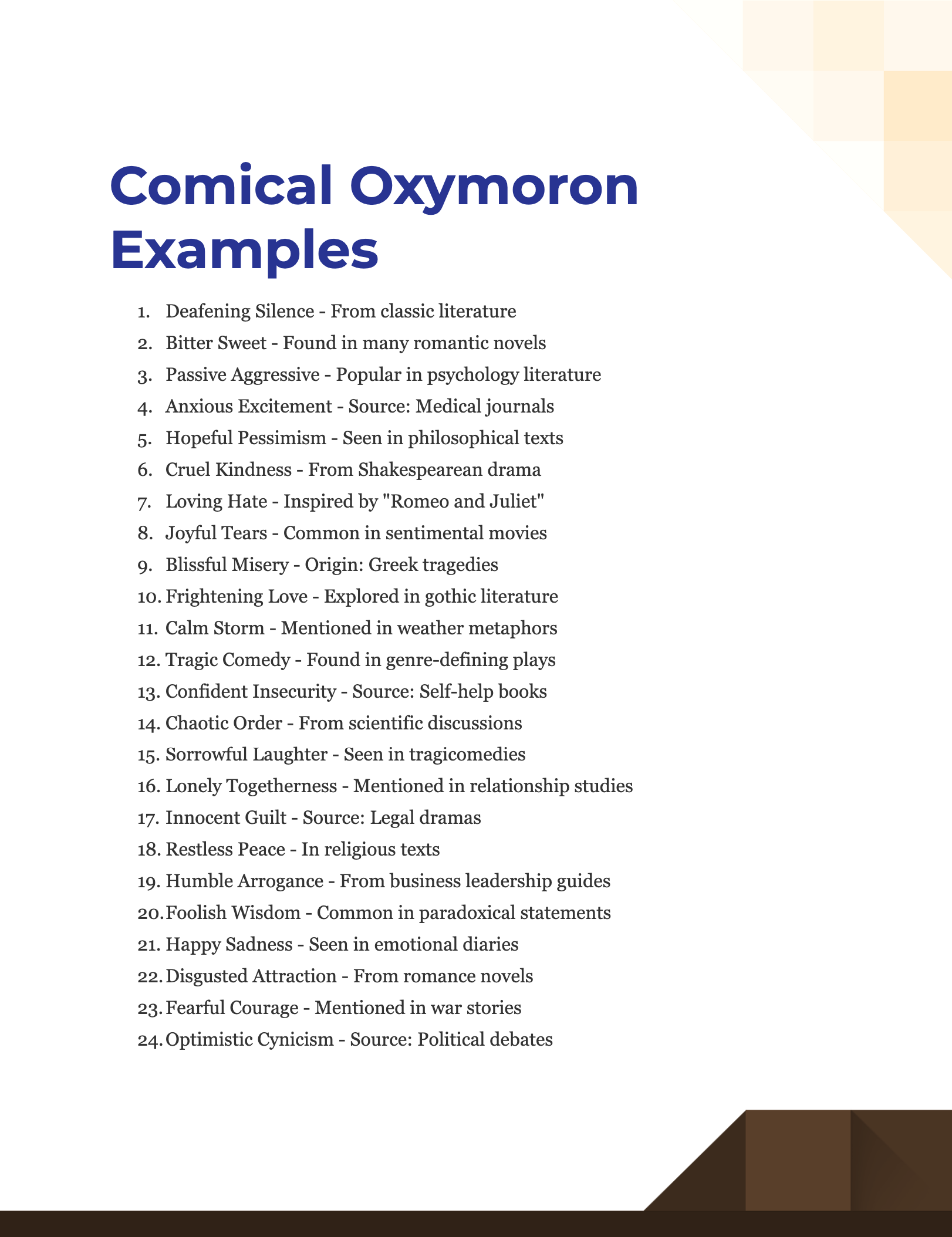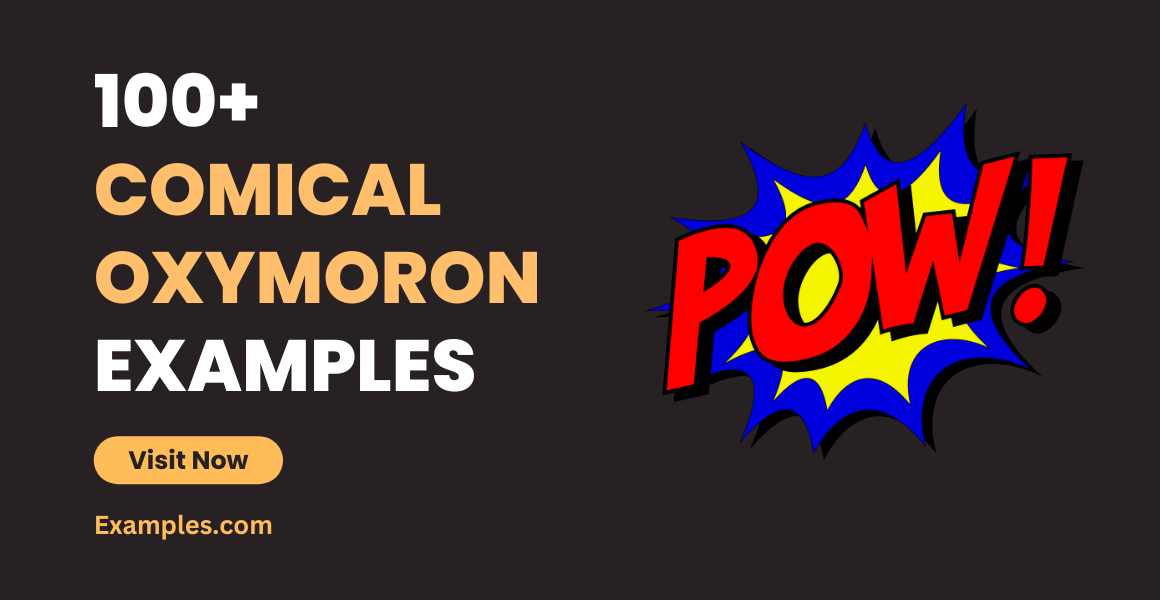Comical Oxymoron
Discover the captivating world of comical oxymorons! These delightful figures of speech can add an extra layer of humor and wit to your writing or conversations. Dive in to explore the tricks of the trade, master the craft, and tickle your funny bone with our unique examples and step-by-step writing guide. If you’re new to the concept of oxymorons, you might want to start with understanding What is Oxymoron?.
What is a Comical Oxymoron? – Definition
A comical oxymoron is a figure of speech that combines contradictory terms to create humor. These paradoxical phrases intentionally juxtapose words that seem incompatible but result in a funny or intriguing statement. For a deeper dive into the literary aspects of oxymorons, check out Oxymoron in Literature.
What is the best Example of a Comical Oxymoron?
One classic example of a comical oxymoron is the phrase “deafening silence.” It’s humorous because the idea of silence being loud is a paradox. Yet, it perfectly captures the essence of a moment so silent that it becomes almost overwhelming, evoking laughter or amusement. If you’re interested in how oxymorons are used in poetry, you might enjoy Oxymoron in Poetry.
100 Comical Oxymoron Examples

Unearth the quirky charm of comical oxymorons with this curated list. These examples are perfect to spruce up your creative writing, punch up your comedy routines, or enliven everyday conversation. We’ve sourced examples from literature, pop culture, and everyday language to provide a comprehensive array of humor and wit. For a kid-friendly version, check out Oxymoron for Kids.
- Deafening Silence – Common Usage
- Seriously Funny – Stand-up Comedy
- Virtual Reality – Tech Industry
- Same Difference – Common Usage
- Living Dead – “Night of the Living Dead” (film)
- Jumbo Shrimp – Food Industry
- Original Copy – Publishing
- Passive-Aggressive – Psychology
- Random Order – Mathematics
- Found Missing – Police Reports
- Only Choice – Philosophy
- Act Naturally – Oxymoron in Song Lyrics
- Old News – Journalism
- Small Crowd – Event Planning
- Awfully Good – Common Usage
- Freezer Burn – Kitchen Terminology
- Clearly Confused – Psychology
- Growing Smaller – Biology
- Even Odds – Gambling
- Deceptively Honest – Legal Jargon
- Tragic Comedy – Theater
- Liquid Gas – Chemistry
- Quiet Riot – Music Band
- Cruel Kindness – Literature
- Minor Crisis – Business
- Working Vacation – Corporate Culture
- Mandatory Option – Legislation
- Irregular Pattern – Design
- Constant Change – Philosophy
- Unbiased Opinion – Journalism
- Passive Resistance – History
- Restless Sleep – Health
- Lesser Evil – Ethics
- Advanced Basic – Education
- Bittersweet Symphony – Music
- Exact Estimate – Construction
- Controlled Chaos – Physics
- Authentic Replica – Art
- Temporary Fix – Maintenance
- Holy War – Religious Conflicts
- Awfully Pretty – Fashion
- Alone Together – Relationships
- Almost Perfect – Beauty Standards
- Painful Pleasure – Literature
- Pretty Ugly – Common Usage
- Seriously Joking – Comedy
- Living End – Literature
- Organized Mess – Lifestyle
- Falsely True – Paradoxes
- Known Secret – Espionage
- Open Secret – Political Terminology
- Passive Action – Philosophy
- Sad Smile – Emotional Expression
- Negative Growth – Economics
- Civil War – History
- Friendly Fire – Military
- Great Depression – Economics
- Walking Dead – Television Show
- Terribly Pleased – Common Usage
- Literally Figurative – Language Arts
- Peace Force – United Nations
- Larger Half – Mathematics
- Passive Aggression – Psychology
- Liquid Solid – Chemistry
- Quiet Scream – Horror Films
- Harmonic Dissonance – Music
- Rolling Stop – Driving
- Oddly Normal – Common Usage
- Old Baby – Common Usage
- Harmless Poison – Medical Research
- Artificial Reality – Tech Industry
- Constant Variable – Mathematics
- General Specifics – Management
- Painfully Beautiful – Art
- Paid Volunteer – Social Work
- Hell’s Angels – Biker Group
- Cautiously Optimistic – Psychology
- Alone in a Crowd – Literature
- Partially Complete – Project Management
- Deliberate Mistake – Artistic Technique
- Silent Scream – Psychological Horror
- Fixed Variable – Scientific Research
- Living Hell – Common Usage
- Accurate Rumor – Journalism
- Near Miss – Aviation
- Guest Host – Television
- Seriously Casual – Fashion
- Incredibly Real – Virtual Reality
- Uninvited Guest – Social Gathering
- Real Fantasy – Gaming
- Virtual Substance – Sci-fi Literature
- Active Standstill – Physics
- True Lies – Film Title
- Actively Lazy – Common Usage
- Small Fortune – Business
- Certain Possibility – Statistics
- Same Opposite – Logic
- Purposeful Accident – Art
- Real Mirage – Natural Phenomena
- Openly Secretive – Politics
Comical Oxymoron Examples for Kids
Here’s a lively collection of comical oxymorons tailored just for kids! These playful contradictions in terms will not only broaden their vocabulary but also tickle their funny bones. Ideal for learning and giggles!
- Tiny Elephant – Children’s Story
- Dry Lake – Geography Class
- Slow Sprint – P.E. Lessons
- Quiet Noise – Bedtime Tales
- Frozen Sun – Science Class
- Happy Tear – Emotion Lesson
- Laughing Cry – Children’s Movies
- Empty Cookie Jar – Home Life
- Harmless Monster – Cartoon Shows
- Found Missing – Detective Games for Kids
Comical Oxymoron Examples in a Sentence
Oxymorons can be a hilarious way to spice up your sentences. If you’re looking to add some comedy to your writing or conversation, these examples will provide you the perfect blend of humor and complexity.
- “She wore a seriously funny hat.” – Conversational English
- “The comedian delivered a tragically funny punchline.” – Stand-up Comedy
- “It was a deafening silence during the prank.” – Narratives
- “He ate a jumbo shrimp cocktail.” – Food Reviews
- “The meeting was an open secret among the staff.” – Corporate Setting
- “He managed to create a living statue.” – Performance Art
- “It was a random pattern on the wallpaper.” – Interior Design
- “His act was foolishly wise.” – Theatre
- “The artist drew a simple complex design.” – Art Blogs
- “She sang a melancholy tune that made everyone laugh.” – Music Reviews
What do Oxymorons Represent?
Oxymorons are fascinating figures of speech that combine contradictory or opposing words to create a new, often complex meaning. By fusing opposing elements, oxymorons serve to grab attention and make the audience think. They can add flair to poetic language, deepen the nuance in prose, and even introduce humor or irony. So, when you come across phrases like “jumbo shrimp,” “deafening silence,” or “living dead,” you’re witnessing the power of oxymorons to make language more engaging, thought-provoking, and entertaining. They reveal the complexities and contradictions inherent in human thought, emotion, and existence.
What is a Comical Oxymoron for Kids?
A comical oxymoron for kids is essentially an oxymoron that’s been chosen or framed in a way that makes it especially amusing for a younger audience. These are not just linguistic exercises; they’re also tools for entertainment and education. They capture children’s imaginations while teaching them the richness of language. Comical oxymorons for kids often appear in stories, jokes, and educational material aimed at making learning a more engaging experience. Phrases like “giant dwarf” or “seriously funny” can elicit giggles, but they also help children grasp the flexible, multi-layered nature of language. Overall, they serve as fun entry points for understanding more advanced literary devices and enriching their vocabulary.
When incorporated thoughtfully, comical oxymorons can make language learning a delight for kids, turning it into an exploratory journey full of surprises and ‘aha’ moments. So, the next time you want to captivate a young audience, consider sprinkling in some comical oxymorons. They are sure to both educate and entertain, all while making the language come alive in new and unexpected ways.
How do you write a Comical Oxymoron? – Step by Step Guide
Creating a comical oxymoron is not only a fun exercise but also a great way to engage your audience. It requires a keen sense of humor, a good grasp of language, and a touch of creativity. Here’s how to do it:
Step 1: Understand the Basics
Familiarize yourself with the concept of an oxymoron. Remember, it’s a figure of speech that combines contradictory or opposing words.
Step 2: Identify Your Target Audience
Know your audience. If you’re targeting kids, your oxymorons should be simple yet engaging. For adults, you might opt for something more sophisticated.
Step 3: Brainstorm Contradictory Words
List down words that are opposites or generally contradictory. For example, ‘small’ and ‘giant’, ‘quiet’ and ‘loud’, or ‘serious’ and ‘funny’.
Step 4: Pair the Words
Combine these contradictory words to create a short phrase. E.g., ‘seriously funny’, ‘deafening silence’, ‘awfully good’.
Step 5: Test for Comical Effect
Say the phrase out loud or ask someone else to read it. Does it sound funny? If not, try a different combination.
Step 6: Use it in Context
Place the oxymoron into a sentence or story that adds to its comical effect. Sometimes the surrounding context can amplify the humor.
Step 7: Final Check
Read the whole text to make sure the comical oxymoron fits naturally and enhances the humor.
Step 8: Review and Revise
Don’t hesitate to tweak the oxymoron or the surrounding text until you achieve the desired level of comedy.
Tips for Using Comical Oxymoron
- Keep It Simple: Especially for younger audiences, a simple oxymoron is easier to understand and find amusing. For more tips on how to write oxymorons, you can visit Oxymoron Figure of Speech.
- Context Matters: An oxymoron can be much funnier when used in the right context. Make sure it complements the story or message. For more examples that will make you laugh, check out Funny Oxymoron.
- Balance is Key: While oxymorons are meant to be contradictory, they should also make sense to some degree. The contradiction should be clever, not confusing. For oxymorons that touch the heart, explore Emotional Oxymoron.
- Experiment: Don’t be afraid to play around with different combinations of words. Creativity can lead to the most hilarious oxymorons. If you’re looking for oxymorons that describe things, you might like Descriptive Oxymoron.
- Timing: Like any joke, timing is crucial. Place your oxymoron where it can have the most impact, often at the end of a sentence or as a punchline. For oxymorons you encounter in daily life, see Everyday Oxymoron.
- Audience Reaction: Pay attention to how your audience reacts to different oxymorons. This will give you a better sense of what works and what doesn’t.
- Multi-Use: Sometimes, a comical oxymoron can serve multiple purposes like adding humor while also driving home a point or emphasizing a contrast.
- Quality Over Quantity: It might be tempting to fill your text with multiple oxymorons, but too many can dilute the effect. One well-placed oxymoron can often be more effective than several mediocre ones.
- Consult Others: Sometimes what’s funny to one person might not be to another. It’s always a good idea to get a second opinion.
- Have Fun: The most important tip is to enjoy the process. Writing should be fun, and creating comical oxymorons is an excellent way to add a dash of humor to your work.
Follow these steps and tips, and you’re well on your way to mastering the art of the comical oxymoron, injecting both humor and depth into your writing.



